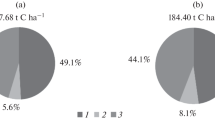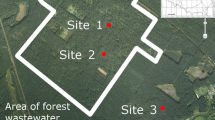Abstract
Field studies of photosynthesis in Pinus contorta/Pinus banksiana (lodgepole pine/jack pine) hybrids, Picea glauca (white spruce) and Populus tremuloides (aspen) subjected to SO2 and H2S from a nearby natural gas processing plant were initiated near Whitecourt, Alberta, Canada during the summer of 1974. The site was characterized as a Pinus-Picea glauca/Arctostaphylos uva-ursi association (pine-white spruce/bearberry). A 15 m high scaffold was used as access to mid-crown foliage in the pines while the spruce and aspen were accessible from the round. Net assimilation rates, transpiration rates and leaf resistances were calculated and water deficits were monitored. Photosynthetic rates measured were in a low range for the conifers studied, with pine having a maximum of 3.28 mg dm−2 h−1 and white spruce a maximum value of 2.3 mg dm−2 h−1 The low maximum photosynthetic rate determined for aspen is thought to be attributable to the onset of autumn. Chemical analyses for SO4-sulfur using the methylene blue colorimetric method of Johnson and Nishita (1952) showed levels of 300 to 700 ppm, with the older foliage showing slightly higher values. Visible chronic S02 symptoms had a pronounced sun, or upward, orientation. Ambient SOD H2S and total S were measured using a Tracor 270HA Atmospheric Sulfur Analyzer (chromatographic method) and trends in ambient SO2 concentrations using an Envirometrics SO2 Analyzer (polarographic method). Concentration was found to be variable for SO2 and generally below 0.05 ppm. A concentration gradient of SO2 was found to exist in the lodgepole pine/jack pine stand with the SO2 values above the canopy generally higher than below the canopy (0.1 ppm above and 0.05 ppm below). This condition was occasionally reversed. The plant canopy is considered to act as a barrier to downward diffusion of the S emissions in the first case and also a barrier to upward diffusion of S emissions present due to advection in the stand in the second case. The vegetative environment surrounding the Windfall Gas Plant is definitely affected by S gas emissions but the extent remains to be determined.
Similar content being viewed by others
References
Bierhuizen, J. F. and Slatyer, R. O.: 1964, ‘Photosynthesis and Transpiration under Controlled Environmental Conditions’, In: Tech. Bull. #36. Institute for Land and Water Management Research, Wageningen, The Netherlands.
Bowen, H. J. M.: 1965, Watsonia 6, 114.
Brody, S. S. and Chaney, J. E.: 1966, J. Gas Chromatography, 42.
Daines, R. H.: 1o68, J. Occupational Medicine 10, 516.
Daubenmire, R. F. Daubenmire, J. B.: 1968, ‘Forest Vegetation of Eastern Washington and Northern Idaho’, Washington Agricultural Experiment Station Tech. Bull. #60.
Dykstra, G. F.: 1974, Can. J. Forest Res. 4, 201.
Fry, K. E.: 1965, ‘A Study of Transpiration and Photosynthesis in Relation to the Stomatal Resistance and Internal Water Potential in Douglas-Fir’, Ph.D. dissertation, Univ. of Washington, Seattle.
Guderian, R. and Van Haut, H.: 1970, Staub-Reinhalt. Luft 30, 22.
Halliday, W. E. D.: 1937, ‘A Forest Classification for Canada’, Canadian Forestry Service Bull. #89. 50 pp.
Hickling, L. L.: 1974, The Effects of SO2 Fumigation on Net Photosynthesis of Douglas-Fir’, M.Sc. Thesis, Univ. of Washington, Seattle.
Johnson, C. M. and Nishita, H.: 1952, Analytical Chemistry 24, 736.
Legge, A. H.: 1973, ‘Sulphur Dioxide and Environmental Prestressing of Vegetation’, in Whitecourt Environmental Study — 1973.
Legge, A. H. and Harvey, G. W.: 1974, ‘Sulfur Dioxide and Environmental Preconditioning of Vegetation’, in Whitecourt Environmental Study — 1974.
Lopushinsky, W. and Klock, G. O.: 1974, Forest Science 20, 181.
Majernik, O. and Mansfield, T. A.: 1970, Nature, 277, 377.
Majernik, O. and Mansfield, T. A.: 1971, Phytopath. Z. 71, 123.
Mansfield, T. A. and Majernik, O.: 1970, Environmental Pollution 1, 149.
Meidner, H. and Mansfield, T. A.: 1968, Physiology of Stomata, McGraw Hill, New York and London.
Neilson, R. E., Ludlow, M. M., and Jarvis, P. G.: 1972, J. Appl. Ecol. 9, 721.
Pike, L. H., Denison, W. C., Tracy, D. M., Nielsen, D., Sherwood, M. A., and Rhoades, F. M.: 1975, ‘A Floristic Survey of the Epiphytic Lichens and Bryophytes Growing on the Trunk, Branches, and Twigs of Living Old-Growth Conifers in Western Oregon’ (unpubl. manuscript).
Rowe, J. S.: 1972, ‘Forest Regions of Canada’, Department of the Environment, Canadian Forest Service Publication #1300. 172 pp.
Salo, D. J.: 1974, ‘Factors Affecting Photosynthesis in Douglas-Fir’, Ph.D. dissertation, Univ. of Washington, Seattle.
Salo, D. J., Ringo, J. A., Nishitani, J. H., and Walker, R. B.: 1972, in Proceedings —Research on Coniferous Forest Ecosystems — a Symposium (J. F. Franklin, L. J. Dempster and R. H. Waring, eds.), Pacific Northwest Forest and Range Station, Portland.
Scheffer, T. C and Hedgecock, G. C.: 1955, ‘Injury to Northwest Forest Trees by Sulfur Dioxide from Smelters’, USDA Tech. Bull. #1117.
Skorepa, A. C. and Vitt, D. H.: 1975, ‘A Quantitative Analysis of Lichen Vegetation in Relation to SO2 Pollution at Rocky Mountain House, Alberta’, Alberta Sulphur Gas Research Workshop II, January 16–17, 1975, Environmental Sciences Centre (Kananaskis).
Stratmann, H. and Van Haut, H.: 1960, ‘Experimentelle Untersuchungen uber die Wirkung von Schwefeldioxyd auf die Vegetation’, in Forschungsberichte des Landes Nordrhein-Westfalen, 24 pp.
Tamm, C. O. and Aronsson, A.: 1972, ‘Plant Growth as Affected by Sulfur Compounds in a Polluted Atmosphere’, #12 in a series. Research notes from the Dept. of Forest Ecology and Forest Soils, College of Forestry Stockholm. 54 pp.
Tanaka, H., Takanashi, T., and Yatazawa, M.: 1974. Water, Air Soil Pollut. 3, 11.
Thomas, M. D.: 1961, in Air Pollution, World Health Organization Monograph Series #46.
Thomas, M. D. and Hill, G. R.: 1937, Plant Physiol. 12, 309.
Thomas, M. D., Hendricks, R. H., and Hill, G. R.: 1950, Soil Sci. 70, 9.
Thompson, F. B. and Leyton, L.: 1971, Nature, 229, 572.
Ulrich, A., Tabatabai, M. A., Ohki, K., and Johnson, C. M.: 1967, Plant Soil. 26, 235.
Van Zinderen Bakker, E. M.: 1914, ‘An Ecophysiological Study of Black Spruce in Central Alberta’, Ph.D. dissertation, Univ. of Alberta, Edmonton.
Waring, R. H. and Cleary, B. D.: 1967, Science 155, 1248.
Westman, L.: 1974, Ambio 3, 189.
Whittaker, R. H.: 1956, Ecological Monographs 26, 1.
Ziegler, I.: 1974, Biochem. Biophys. Acta 364, 28.
Author information
Authors and Affiliations
Rights and permissions
About this article
Cite this article
Legge, A.H., Jaques, D.R., Amundson, R.G. et al. Field studies of pine, spruce and aspen periodically subjected to sulfur gas emissions. Water Air Soil Pollut 8, 105–129 (1977). https://doi.org/10.1007/BF00156729
Received:
Issue Date:
DOI: https://doi.org/10.1007/BF00156729




